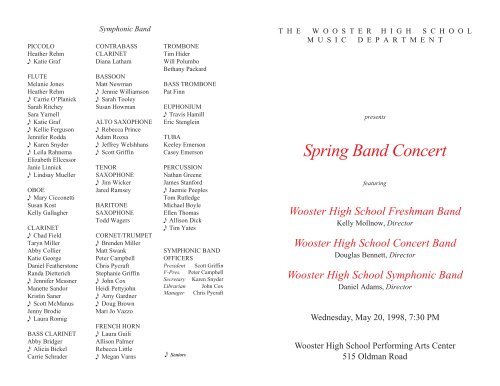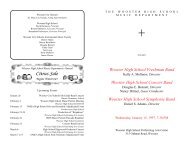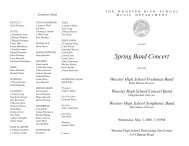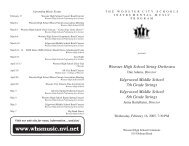Spring Band Program 98ol - Wooster High School Music Department
Spring Band Program 98ol - Wooster High School Music Department
Spring Band Program 98ol - Wooster High School Music Department
Create successful ePaper yourself
Turn your PDF publications into a flip-book with our unique Google optimized e-Paper software.
PICCOLO<br />
Heather Rehm<br />
� Katie Graf<br />
FLUTE<br />
Melanie Jones<br />
Heather Rehm<br />
� Carrie O’Planick<br />
Sarah Ritchey<br />
Sara Yarnell<br />
� Katie Graf<br />
� Kellie Ferguson<br />
Jennifer Rodda<br />
� Karen Snyder<br />
� Leila Rahnema<br />
Elizabeth Ellcessor<br />
Janie Linnick<br />
� Lindsay Mueller<br />
OBOE<br />
� Mary Cicconetti<br />
Susan Kost<br />
Kelly Gallagher<br />
CLARINET<br />
� Chad Field<br />
Taryn Miller<br />
Abby Collier<br />
Katie George<br />
Daniel Featherstone<br />
Randa Dietterich<br />
� Jennifer Messner<br />
Manette Sandor<br />
Kristin Saner<br />
� Scott McManus<br />
Jenny Brodie<br />
� Laura Romig<br />
BASS CLARINET<br />
Abby Bridger<br />
� Alicia Bickel<br />
Carrie Schrader<br />
Symphonic <strong>Band</strong><br />
CONTRABASS<br />
CLARINET<br />
Diana Latham<br />
BASSOON<br />
Matt Newman<br />
� Jennie Williamson<br />
� Sarah Tooley<br />
Susan Howman<br />
ALTO SAXOPHONE<br />
� Rebecca Prince<br />
Adam Rozsa<br />
� Jeffrey Welshhans<br />
� Scott Griffin<br />
TENOR<br />
SAXOPHONE<br />
� Jim Wicker<br />
Jared Ramsey<br />
BARITONE<br />
SAXOPHONE<br />
Todd Wagers<br />
CORNET/TRUMPET<br />
� Brenden Miller<br />
Matt Swank<br />
Peter Campbell<br />
Chris Pycraft<br />
Stephanie Griffin<br />
� John Cox<br />
Heidi Pettyjohn<br />
� Amy Gardner<br />
� Doug Brown<br />
Mari Jo Vazzo<br />
FRENCH HORN<br />
� Laura Guili<br />
Allison Palmer<br />
Rebecca Little<br />
� Megan Varns<br />
TROMBONE<br />
Tim Hider<br />
Will Polumbo<br />
Bethany Packard<br />
BASS TROMBONE<br />
Pat Finn<br />
EUPHONIUM<br />
� Travis Hamill<br />
Eric Stenglein<br />
TUBA<br />
Keeley Emerson<br />
Casey Emerson<br />
PERCUSSION<br />
Nathan Greene<br />
James Stanford<br />
� Jaemie Peeples<br />
Tom Rutledge<br />
Michael Boyle<br />
Ellen Thomas<br />
� Allison Dick<br />
� Tim Yates<br />
SYMPHONIC BAND<br />
OFFICERS<br />
President Scott Griffin<br />
V-Pres. Peter Campbell<br />
Secretary Karen Snyder<br />
Librarian John Cox<br />
Manager Chris Pycraft<br />
� Seniors<br />
T H E W O O S T E R H I G H S C H O O L<br />
M U S I C D E P A R T M E N T<br />
presents<br />
<strong>Spring</strong> <strong>Band</strong> Concert<br />
featuring<br />
<strong>Wooster</strong> <strong>High</strong> <strong>School</strong> Freshman <strong>Band</strong><br />
Kelly Mollnow, Director<br />
<strong>Wooster</strong> <strong>High</strong> <strong>School</strong> Concert <strong>Band</strong><br />
Douglas Bennett, Director<br />
<strong>Wooster</strong> <strong>High</strong> <strong>School</strong> Symphonic <strong>Band</strong><br />
Daniel Adams, Director<br />
Wednesday, May 20, 1998, 7:30 PM<br />
<strong>Wooster</strong> <strong>High</strong> <strong>School</strong> Performing Arts Center<br />
515 Oldman Road
<strong>Program</strong><br />
Freshman <strong>Band</strong><br />
Happy Times March (1997) Warren Barker<br />
(b. 1923)<br />
El Mirador: Scenes from a Lost Mayan Village (1988) Paul Jennings<br />
The Muppet Movie Medley (1979) Paul Williams and Kenny Ascher<br />
arranged by John Edmondson<br />
A Day at the Races (1996) arranged by L. C. Harnsberger<br />
Members of Symphonic <strong>Band</strong><br />
Octet in E Flat Major, Op. 103 (1792) Ludwig van Beethoven<br />
(1770-1827)<br />
Laura Guili and Allison Palmer, horn Mary Cicconetti and Susan Kost, oboe<br />
Chad Field and Taryn Miller, clarinet Matt Newman and Jennie Williamson, bassoon<br />
Concert <strong>Band</strong><br />
Whip & Spur March Thomas S. Allen<br />
(1876-1919)<br />
arranged by Ray E. Cramer<br />
Big <strong>Band</strong> Bash (1981) Bob Lowden<br />
Concerto for Faculty & Concert <strong>Band</strong> (1972) James Ployhar<br />
(b. 1926)<br />
Soloists: David Burnison, Mike Gallagher, Kevin Hennis,<br />
Mike Hallett, Dennis Jordon, Miriam Stokes and Melanie Vinion<br />
Symphonic <strong>Band</strong><br />
Lord, Guard and Guide (The Men Who Fly) (1993) Robert Jager<br />
(b. 1939)<br />
Slava! (1977) Leonard Bernstein<br />
(1918-1990)<br />
transcribed by Clare Grundman<br />
The Stars and Stripes Forever March (1896) John Philip Sousa<br />
(1854-1932)<br />
PICCOLO<br />
Julie Buehler<br />
FLUTE<br />
Nicole Vura<br />
Kelly Lake<br />
Julie Buehler<br />
Angie Doty<br />
Stacey Clark<br />
Tamara Gill<br />
Stephanie Holmes<br />
Katie Novak<br />
Samantha Weaver<br />
Jessie Buchholz<br />
Rebecca Carlson<br />
Crystal Sampson<br />
� Carrie Romig<br />
� Beth Evans<br />
Dani Daubenspeck<br />
Katie Bollinger<br />
� Carrie Gwin<br />
Kris Kraft<br />
Miranda Miller<br />
Jessica Jolly<br />
Senovia Petty<br />
Sarah Napier<br />
Tiffany Guthrie<br />
OBOE<br />
Caitlin Burnell<br />
� Karen Haag<br />
Mollie Amstutz<br />
Concert <strong>Band</strong><br />
CLARINET cont.<br />
Kara Willard<br />
Shileah Cantey<br />
John Mann<br />
Kathy Bishop<br />
Jessica Bakerlis<br />
Kristi Wise<br />
Abby Fair<br />
Jamey Cicconetti<br />
Sarah Britton<br />
� Amy Hall<br />
Bethann Fravel<br />
BASS CLARINET<br />
� Jason Potts<br />
Randi Jo Brenner<br />
ALTO SAXOPHONE<br />
Jamie Parsons<br />
Glenn Davis<br />
� Carmen Biggs<br />
Erin Cosyn<br />
David Hodge<br />
Susan Ditch<br />
Sam Mick<br />
Ollie Spires<br />
TENOR<br />
SAXOPHONE<br />
Trisha Diehl<br />
Jere Sisler<br />
BARI SAXOPHONE<br />
Stephen Apple<br />
TRUMPET cont.<br />
� Serena Sword<br />
Emily Boyle<br />
Ty Bresson<br />
� Chuck Boyer<br />
Martha Shellhorn<br />
HORN<br />
Katie Plumly<br />
Janel Troyer<br />
Natalie Chupp<br />
� Erin Fickes<br />
� Amy Richman<br />
Laura Muskopf<br />
TROMBONE<br />
� Phil Arner<br />
Jeff Adams<br />
� Peter Swank<br />
Amy Anderson<br />
Lisa Lutz<br />
EUPHONIUM<br />
Josh Moore<br />
� Gregory Via<br />
Amanda Wallace<br />
TUBA<br />
Brian Deily<br />
Andy Thornton<br />
Matt Ports<br />
Joe McNeil<br />
Josh Engman<br />
BASSOON<br />
� Katie Yoders<br />
PERCUSSION<br />
TRUMPET/CORNET Todd Fisher<br />
CLARINET<br />
Bobby Hammond Jeff Sczpanski<br />
Hillary Smith<br />
Tim Fluharty<br />
Ed Buchholz<br />
Brandi Engel<br />
� Casey Meek Stephanie Myers<br />
Colleen O’Planick Ryan Lingle<br />
Kevin Clinesmith<br />
Jill Condry<br />
Karen Henery<br />
� Joel Miles<br />
Carmen Hackworth Matt Prince<br />
Kevin Kesner<br />
Lindsey Howell Lisa Canode<br />
Joel Allen<br />
edited by Keith Brion Cathi Gwin<br />
Krystal Girvin<br />
� Seniors
FLUTE<br />
Brenda Coffee<br />
Jenny Kirkham<br />
Jennifer Sellers<br />
Stephanie Stabile<br />
Melissa Mills<br />
Sara Anderson<br />
Candace Barker<br />
Deanna Strauss<br />
OBOE<br />
Sara Novak<br />
Kathy Clifton<br />
CLARINET<br />
Cullen Schmid<br />
Suzi Ohlsen<br />
Tabitha Zimmerman<br />
Alex Sewell<br />
Amber Fisher<br />
Erin Fields<br />
Laura Miller<br />
Regan Radzinski<br />
Jeanette Bolick<br />
Lindsay Cherilla<br />
BASS CLARINET<br />
Jessie Spires<br />
Susan Mills<br />
Freshman <strong>Band</strong><br />
BASSOON<br />
Amber Marty<br />
ALTO SAXOPHONE<br />
Jen Hider<br />
Abby Stansloski<br />
Todd Peeples<br />
Kevin Nash<br />
Josh Rodak<br />
Cameron Hammond<br />
Patrick Moore<br />
TENOR SAXOPHONE<br />
Denice Hall<br />
BARITONE<br />
SAXOPHONE<br />
Kevin Hancock<br />
TRUMPET<br />
Mark Yoders<br />
Matt Fidler<br />
Megan Keating<br />
Ryan Turpin<br />
Mindy Via<br />
Stephanie Carestia<br />
Erica Calame<br />
Upcoming Events<br />
HORN<br />
Elaine Tooley<br />
Casey Roberts<br />
Kate Meister<br />
Anne Matacale<br />
TROMBONE<br />
Molly Moritz<br />
Mason Shamp<br />
Lee Croft<br />
EUPHONIUM<br />
Christina Caine<br />
Bryan Moore<br />
Michael Gifford<br />
TUBA<br />
Brian Hoffman<br />
PERCUSSION<br />
Andy Klise<br />
Nakul Jeirath<br />
Brandon Holman<br />
Susan Iceman<br />
Nick Randall<br />
James Snyder<br />
May 23 Big <strong>Band</strong> Dance<br />
May 25 Memorial Day Parade and Services<br />
May 27 Marching Percussion Tryouts<br />
May 28 <strong>Music</strong> Awards Banquet<br />
June 7 Commencement ~ Symphonic <strong>Band</strong> performs<br />
<strong>Program</strong> Notes<br />
Warren Barker is well known for his arrangements of Broadway and<br />
American popular music for the concert band. Happy Times March, composed in 1997,<br />
includes simple syncopated “jazz” figures designed to create a happy, festive feeling.<br />
* * *<br />
El Mirador: Scenes from a Lost Mayan Village, composed in 1988 by Paul<br />
Jennings, has three separate movements. The Tigre Pyramid opens with a repeated halfstep<br />
pattern which leads into a fanfare-like theme in the woodwinds, trumpets, and horns.<br />
The second movement, The Loom of Time, begins with a modal melody played by solo<br />
marimba. This mysterious melody is then played by the woodwinds and then by the<br />
trumpets. This movement is full of interesting nontraditional harmonies. Snake Dancer<br />
uses many percussive effects, played by members of the percussion section as well as<br />
other members of the ensemble.<br />
* * *<br />
Released in 1979, The Muppet Movie was the first full-length movie featuring<br />
the lovable Muppet characters created by the late Jim Henson. It received two Academy<br />
Award Nominations: Best Original Song Score, and Best Original Song for Rainbow<br />
Connection. John Edmondson’s arrangement entitled Muppet Movie Medley features<br />
the lively Movin’ Right Along, the bluesy I Hope That Something Better Comes Along,<br />
and the lyrical Rainbow Connection. Edmondson studied at the University of Florida and<br />
the University of Kentucky and taught in the public schools of central Kentucky from<br />
1960 to 1970. He is an internationally known composer and arranger with over 600<br />
published works. His work as a guest conductor and clinician has taken him to twentyeight<br />
states, four Canadian provinces, and Europe.<br />
* * *<br />
A Day at the Races, arranged by L. C. Harnsberger in 1996, is a fun medley<br />
of “horse tunes.” The day begins with Camptown Races when suddenly the horses are<br />
called to the post by a trumpet fanfare. The bell sounds and... THEY’RE OFF! Out in<br />
front is an arrangement of the Light Cavalry Overture. Far behind is a beautifully<br />
harmonized slow arrangement of Old Grey Mare. Then they’re neck and neck - the Light<br />
Cavalry theme and the William Tell Overture (Lone Ranger) theme. In the stretch it’s the<br />
Old Grey Mare flying on the outside in a jazzy style.<br />
* * *<br />
Thomas S. Allen’s music is reflective of his life as a professional musician in<br />
the world of entertainment. His performing experiences vary from playing with symphony<br />
orchestras, to touring as director of an orchestra for a traveling burlesque show.<br />
Although Allen wrote a considerable amount of music for a variety of dances, acrobatic<br />
acts and short dramatic sketches, most all is forgotten. Only a few rags and galops are still<br />
heard in rodeos, circuses and concerts. Some titles occasionally heard include: General<br />
Mixup, U.S.A., Blue Streak Galop, Horse Marines Battle Royal, and Majestic. Whip &<br />
Spur March was written to be played during an old time rodeo. The recommended galop<br />
performance tempo and style is reserved for the most exciting circus acts and rodeo rides.
Big <strong>Band</strong> Bash is a collection of standard tunes from the 1940’s “Big <strong>Band</strong><br />
Jazz Era”. The songs included in this medley are considered to be signature tunes for the<br />
big bands that made them popular. Following the introduction, the medley begins with<br />
the haunting ballad, Artistry and Rhythm, made popular by the Stan Kenton Orchestra.<br />
Artistry and Rhythm segues into Tuxedo Junction, a WWII Era “jitterbug” favorite by the<br />
Glenn Miller Orchestra. The mood relaxes with the ever-popular Glenn Miller standard,<br />
Moonlight Serenade. The medley continues with the driving swing of Duke Ellington’s<br />
Big <strong>Band</strong> and Billy Strayhorn classic, Take the “A” Train. The piece comes to a<br />
boisterous conclusion with the trademark tune of the Count Basie Orchestra, One<br />
O’clock Jump.<br />
* * *<br />
James Ployhar was born in Valley City, North Dakota. He received a<br />
Bachelor of Science Degree from Valley City College and a Master’s Degree from<br />
Northern Colorado University. Ployhar is considered to be one of the more prolific<br />
composers of educational band music. Concerto for Faculty and Concert <strong>Band</strong> is a<br />
serious addition to the repertoire of the modern wind band. The composition is written<br />
in a classical style and is scored in four distinct sections, including a fanfare, waltz, march<br />
and a finale. Each movement features a variety of soloists who explore the subtleties and<br />
timberal variety of the symphonic percussion section. Our featured soloists include some<br />
very talented members of the <strong>Wooster</strong> <strong>High</strong> <strong>School</strong> Faculty.<br />
* * *<br />
A graduate of the University of Michigan, Robert Jager served for four years<br />
as Staff Arranger at the Armed Forces <strong>School</strong> of <strong>Music</strong>. Jager is the only three-time<br />
winner of the Ostwald Award given by the American <strong>Band</strong>masters Association. He has<br />
also been honored by the National <strong>School</strong> Orchestra Association, the American <strong>School</strong><br />
<strong>Band</strong> Directors Association, and has received the Distinguished Service to <strong>Music</strong> Medal<br />
from Kappa Kappa Psi and the Orpheus Award from Phi Mu Alpha. In 1985, he was a<br />
MacDowell Colony Fellow.<br />
Lord, Guard and Guide (The Men Who Fly) was commissioned by the<br />
Military Airlift Command <strong>Band</strong>, Scott Air Force Base, Illinois. Lt. Colonel Bruce Gilkes<br />
was the Commander/Conductor of the MAC <strong>Band</strong> at the time of commissioning.<br />
The hymn Quebec forms the basis for the composition. This melody is the<br />
source of the music for the United States Air Force hymn, Lord, Guard and Guide. Using<br />
fragments of the hymn-tune, the composition begins with gradually rising lines as the<br />
music begins to take flight. This is followed by soaring lines and harmonies that attempt<br />
to describe the feelings of wonder associated with being free from the earth. A quiet<br />
interlude, primarily for solo woodwinds and percussion, portrays the serenity of life<br />
among the clouds. Culminating the work are two settings of the hymn-tune, first for the<br />
woodwinds alone, and then for the low woodwinds and brass in combination. A short<br />
coda brings back fragments from the “soaring theme” and acts as an amen to the<br />
composition.<br />
* * *<br />
When Mstislav Rostropovich (“Slava“ to his friends) invited Leonard<br />
Bernstein to help him launch his inaugural concerts as <strong>Music</strong> Director of the National<br />
Symphony Orchestra, he also asked him to write a rousing new opening piece for the<br />
festivities. Slava! is the result, and the world premiere took place on October 11, 1977<br />
with Rostropovich conducting his orchestra at the Kennedy Center for the Performing<br />
Arts in Washington, D.C.<br />
The first theme of Slava! is a vaudevillian razz-ma-tazz tune filled with slideslipping<br />
modulations and sliding trombones. Theme two is a canonic tune in 7/8 time. A<br />
very brief development section follows, after which the two themes recur in reverse<br />
order. Near the end they are combined with a quotation from the "Coronation Scene' of<br />
Moussorgsky’s Boris Goudonov, where the chorus sings the Russian word “slava!”<br />
meaning “glory!” In this way, of course, the composer is paying an extra four-bar<br />
homage to his friend “Slava” Rostropovich, to whom this Overture is fondly dedicated.<br />
* * *<br />
The initial reception of The Stars and Stripes Forever was only slightly above<br />
average for a new John Philip Sousa march. It grew gradually in public acceptance, and<br />
with the advent of the Spanish-American War the nation suddenly needed such patriotic<br />
music. Capitalizing on this situation, Sousa used it with maximum effect to climax his<br />
moving pageant, The Trooping of the Colors.<br />
The Stars and Stripes Forever had found its place in history. There was a<br />
vigorous response wherever it was performed, and audiences began to rise as though it<br />
were the national anthem. This became traditional at Sousa <strong>Band</strong> concerts. It was his<br />
practice to have the cornets, trumpets, trombones, and piccolos line up at the front of the<br />
stage for the final trio, and this added to the excitement. Many bands still perform the<br />
piece this way.<br />
With passing years the march has endeared itself to the American people. The<br />
sight of Sousa conducting his own great band in this his most glorious composition<br />
always triggered an emotional response. The piece was expected — and sometimes<br />
openly demanded — at every concert of the Sousa <strong>Band</strong>. Usually it was played<br />
unannounced as an encore. Many former Sousa <strong>Band</strong> members have stated that they<br />
could not recall a concert in which it was not played, and that they too were inspired by<br />
looking into the misty eyes of those in the audience. That the players never tired of it is<br />
surely a measure of its greatness.<br />
Sousa explained to the press that the three themes of the final trio were meant<br />
to typify the three sections of the Untied States. The broad melody, or main theme,<br />
represents the North. The South is represented by the famous piccolo obbligato, and the<br />
West by the bold countermelody of the trombones.<br />
Sousa was very emotional in speaking of his own patriotism. When asked why<br />
he composed this march, he would insist that its strains were devinely inspired. In a Sousa<br />
<strong>Band</strong> program at Willow Grove we find this account:<br />
Someone asked, “Who influenced you to compose Stars and Stripes Forever,”<br />
and before the question was hardly asked, Sousa replied, “God — and I say this in all<br />
reverence! I was in Europe and I got a cablegram that my manager was dead. I was in Italy,<br />
and I wished to get home as soon as possible. I rushed to Genoa, then to Paris and to<br />
England and sailed for America. On board the steamer as I walked miles up and down<br />
the deck, back and forth, a mental band was playing Stars and Stripes Forever. Day after<br />
day as I walked it persisted in crashing into my very soul. I wrote it on Christmas Day,<br />
1896.”





